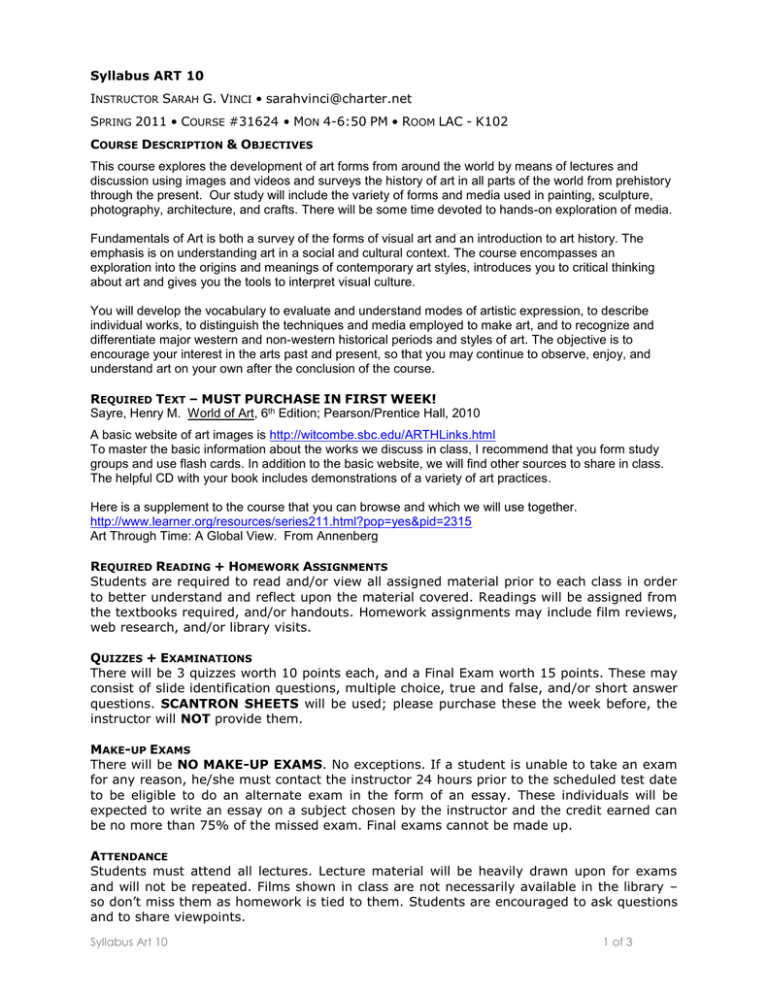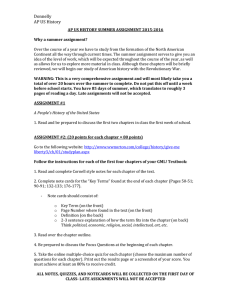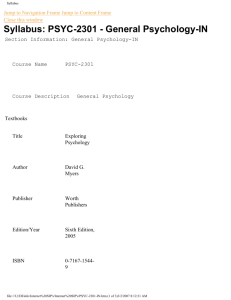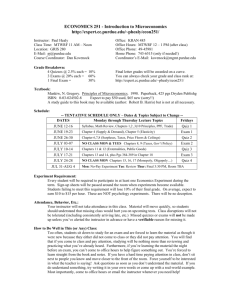
Syllabus ART 10
INSTRUCTOR SARAH G. VINCI • sarahvinci@charter.net
SPRING 2011 • COURSE #31624 • MON 4-6:50 PM • ROOM LAC - K102
COURSE DESCRIPTION & OBJECTIVES
This course explores the development of art forms from around the world by means of lectures and
discussion using images and videos and surveys the history of art in all parts of the world from prehistory
through the present. Our study will include the variety of forms and media used in painting, sculpture,
photography, architecture, and crafts. There will be some time devoted to hands-on exploration of media.
Fundamentals of Art is both a survey of the forms of visual art and an introduction to art history. The
emphasis is on understanding art in a social and cultural context. The course encompasses an
exploration into the origins and meanings of contemporary art styles, introduces you to critical thinking
about art and gives you the tools to interpret visual culture.
You will develop the vocabulary to evaluate and understand modes of artistic expression, to describe
individual works, to distinguish the techniques and media employed to make art, and to recognize and
differentiate major western and non-western historical periods and styles of art. The objective is to
encourage your interest in the arts past and present, so that you may continue to observe, enjoy, and
understand art on your own after the conclusion of the course.
REQUIRED TEXT – MUST PURCHASE IN FIRST WEEK!
Sayre, Henry M. World of Art, 6th Edition; Pearson/Prentice Hall, 2010
A basic website of art images is http://witcombe.sbc.edu/ARTHLinks.html
To master the basic information about the works we discuss in class, I recommend that you form study
groups and use flash cards. In addition to the basic website, we will find other sources to share in class.
The helpful CD with your book includes demonstrations of a variety of art practices.
Here is a supplement to the course that you can browse and which we will use together.
http://www.learner.org/resources/series211.html?pop=yes&pid=2315
Art Through Time: A Global View. From Annenberg
REQUIRED READING + HOMEWORK ASSIGNMENTS
Students are required to read and/or view all assigned material prior to each class in order
to better understand and reflect upon the material covered. Readings will be assigned from
the textbooks required, and/or handouts. Homework assignments may include film reviews,
web research, and/or library visits.
QUIZZES + EXAMINATIONS
There will be 3 quizzes worth 10 points each, and a Final Exam worth 15 points. These may
consist of slide identification questions, multiple choice, true and false, and/or short answer
questions. SCANTRON SHEETS will be used; please purchase these the week before, the
instructor will NOT provide them.
MAKE-UP EXAMS
There will be NO MAKE-UP EXAMS. No exceptions. If a student is unable to take an exam
for any reason, he/she must contact the instructor 24 hours prior to the scheduled test date
to be eligible to do an alternate exam in the form of an essay. These individuals will be
expected to write an essay on a subject chosen by the instructor and the credit earned can
be no more than 75% of the missed exam. Final exams cannot be made up.
ATTENDANCE
Students must attend all lectures. Lecture material will be heavily drawn upon for exams
and will not be repeated. Films shown in class are not necessarily available in the library –
so don’t miss them as homework is tied to them. Students are encouraged to ask questions
and to share viewpoints.
Syllabus Art 10
1 of 3
Date
Class Schedule
Assignments
Week 1: Jan 10
Introduction, Arts Lab
Fundamentals of Art/Chapter 1
Class Exercise: Portrait
Read: Chapters 1, 2 & 3
Homework 1: Language of Art
Week 2: Jan 17
NO CLASS – KING DAY
Week 3: Jan 24
Homework 1 Due
Lecture: Chapter 2 & 3
Class Exercise: Landscape
Week 4: Jan 31
Lecture: Chapters 4, 5, 6
Week 5: Feb 7
Week 6: Feb 14
Homework 2 Due
Lecture: 7 & 8
Quiz #1: Chapters 4-8, Formal Analysis
Lecture: Chapter 9
Drawing Demonstration: Midterm Project
Read: Chapters 4, 5, & 6
Read: Chapters 7, & 8
Homework 2: Finding a Value
Scale
Study for Quiz #1
Read: Chapter 9
Read: Chapters 10 & 11
Week 7: Feb 21
NO CLASS – Washington’s Day
Week 8: Feb 28
Lecture: Chapter 10 & 11
Read: Chapters 12 & 13
Week 9: Mar 7
Lecture 12 & 13
Study for Quiz #2
Mid-term Project due Mar 14
Week 10: Mar 14
Quiz #2: Chapters 9-13
Midterm Project due, Class Critique
Read: Chapters 14, 15 & 16
Week 11: Mar 21
Lecture: Chapter 14, 15 & 16
Study for Quiz #3
Read: Chapter 17
Week 12: Mar 28
Quiz #3: Chapters 14-16
Lecture: Chapters 17
Read: Chapter 18
Week 13: Apr 4
Lecture: Chapter 18
Film: Medici: Godfathers of the Renaissance
Week 14: Apr 11
Week 15: Apr 18
Homework 3 due
Lecture: Chapter 19
Museum Papers Due
Lecture: Chapters 20
Discussion: Final Project
Read: Chapter 21
Week 16: Apr 25
SPRING BREAK
Week 17: May 2
Lecture: Chapter 21
Film: Man Ray
Discussion: Final Project
Week 18: May 9
Homework 4 Due
Review for Final Exam
Film: Betye Saar
One on One Student Instructor meeting
Week 19: May 16
Final Project Due - Class Critique
Week 20: May 23
Final Exam: Chapters 19-21
4 Homework Assignments: 5 points each =
3 Quizzes: 10 points each =
Final Exam
Museum Paper
Midterm Project: Drawing
Final Project: Combines
Total:
Syllabus Art 10
Homework 3: Medici worksheet,
due Apr 11
Read: Chapter 19
Museum Paper Due April 18
Read: Chapter 20
Homework 4: Man Ray
worksheet, due May 9
Bring ideas and items for
instructor meeting
Study for Final Exam
20 points
30 points
15 points
10 points
10 points
15 points
100 points
2 of 3
ONLINE FILES can be found at: http://de.lbcc.edu/e-courses/webenhanced/ – Art &
Photography, click on Art 10, under my name Sarah Vinci
MUSEUM PAPER
The paper is based on a visit to a museum exhibition, a list will be provided by the
instructor of approved museums. Your goal is to analyze the work in person, and using the
formal analysis vocabulary we have been learning in class, write about the work.
Include:
What is the subject matter, or the narrative of the work? If the museum provides the
answer, do you agree with their analysis, and why or why not. Does the title give you
clues, how so.
Medium: What media did the artist use to make the work? How does the artist use line,
color and perspective? If you looking at photography, how did the artist frame the shot
to showcase the line and/or perspective?
Questions: what questions are unresolved by your visual analysis, and the museums
printed material? Now go research the artist and the period to see if you can find the
answer; use the library and the web. Must have 3 sources and at least one must be a
book other than your textbook.
Papers are due on April 18th. In fairness to other students, no papers will be accepted after
this date, no exceptions. They may however be turned in anytime prior to the due date. All
papers must follow the following guidelines:
3-4 pages in length typed and double-spaced; use plain type no larger than 12
points (no longer than 500 words); include a postcard, picture or a drawing of the
work you are discussing.
A ticket stub must be attached to the paper as proof of museum visit
Must use the library and actual books for research!
Footnotes should be at the bottom of each page
Must include a bibliography of all reference materials at the end, use more than one
(Wikipedia is not an acceptable reference site, however it is a good starting point.)
Credit must be given to the proper authority, plagiarism will not be tolerated.
Paper must include a cover page with your NAME, and title of the paper
Report covers are not necessary, however in lieu of a report cover, please staple
securely in the upper left hand corner.
FINAL NOTES
Turn off pagers and cell phones during class time.
Please do not eat in class.
Please do not bring young children to class.
Please speak with the instructor if you have special needs or problems of any kind.
Cheating or disruptive behavior in class may result in automatic dismissal.
The syllabus is a guide; the instructor reserves the right to make changes to reading
assignments, or exams if necessary.
Students are expected to attend the first day of class, instructor reserves the right to
drop any student who does not attend class.
Syllabus Art 10
3 of 3






